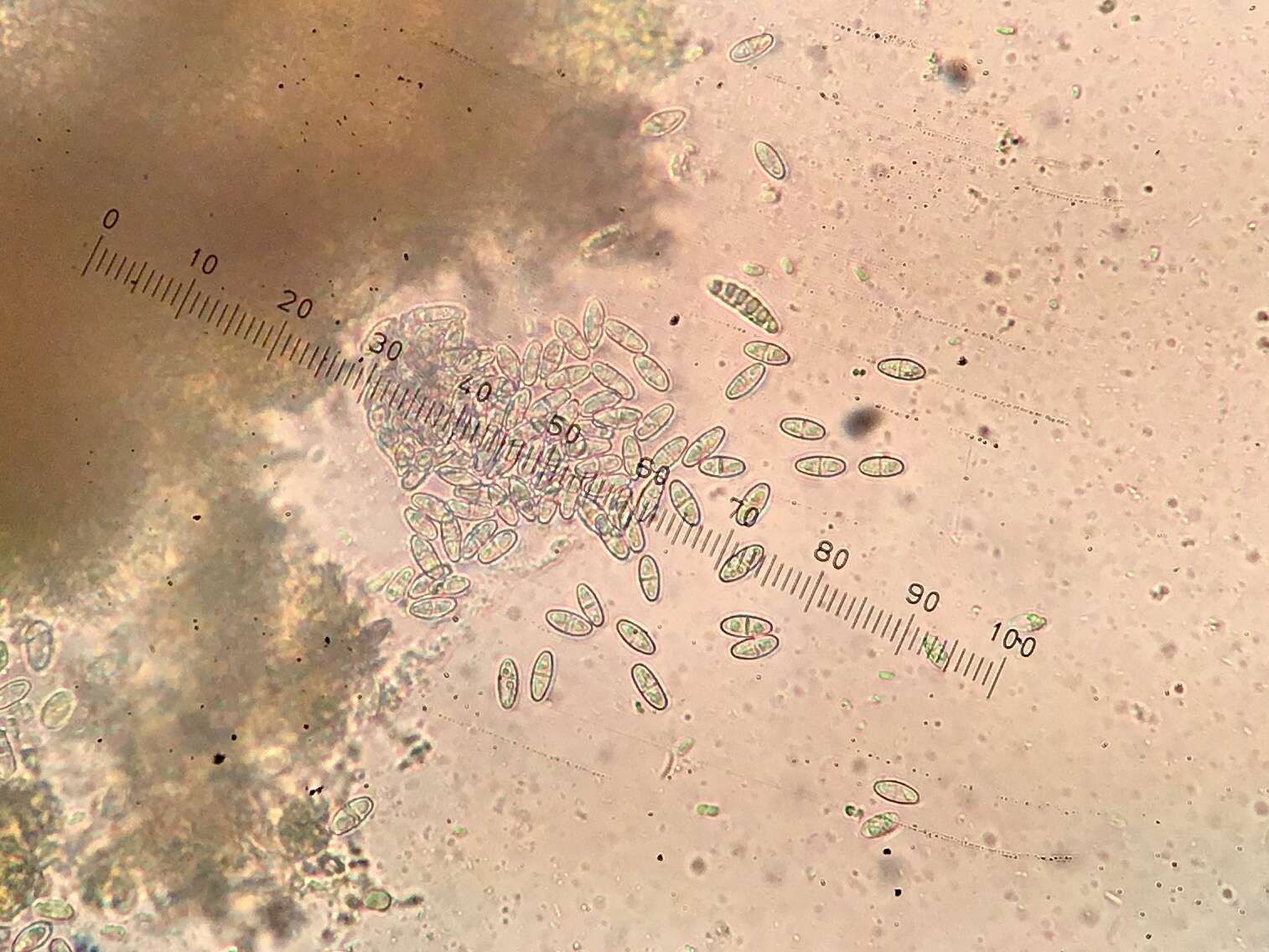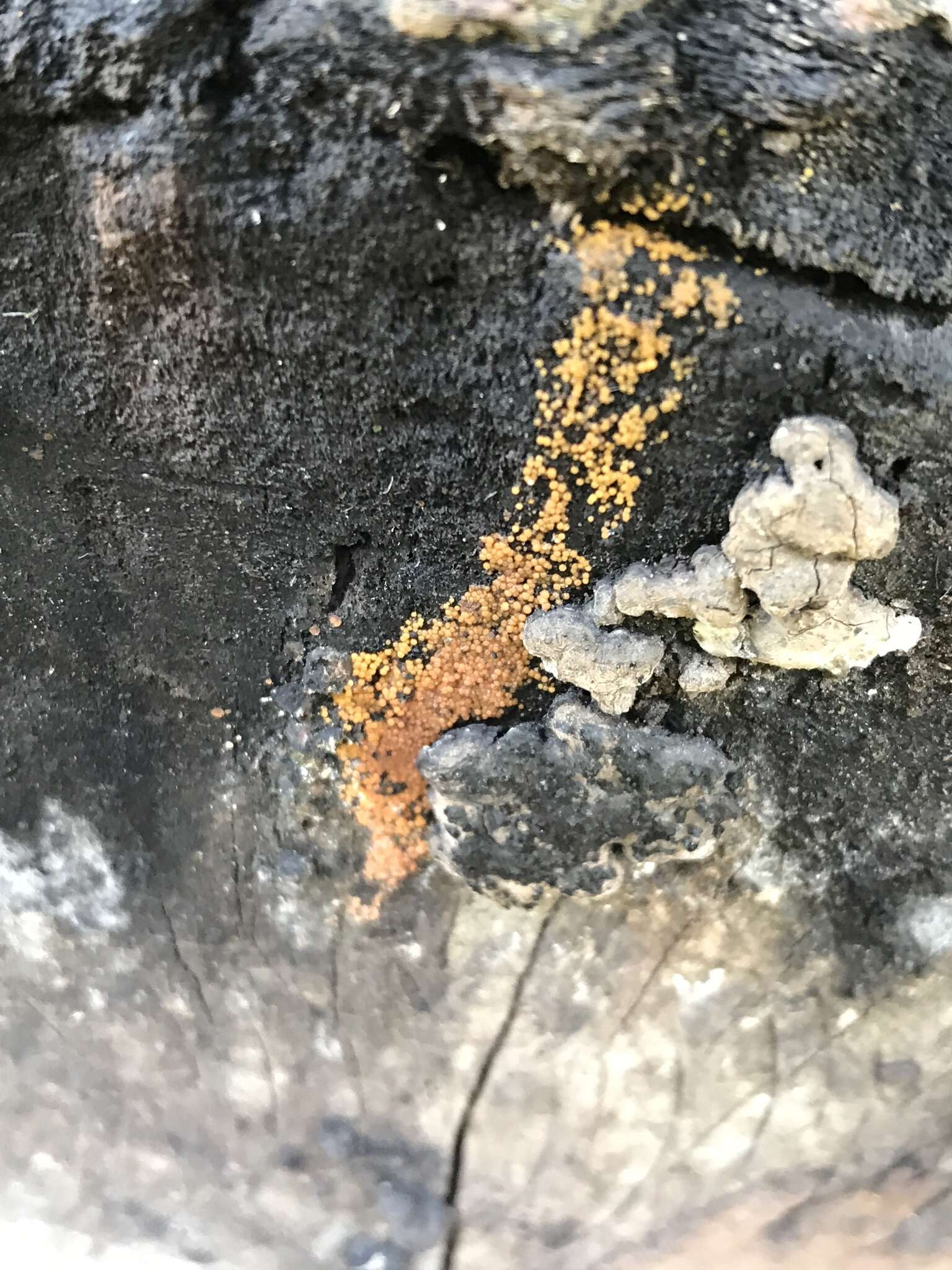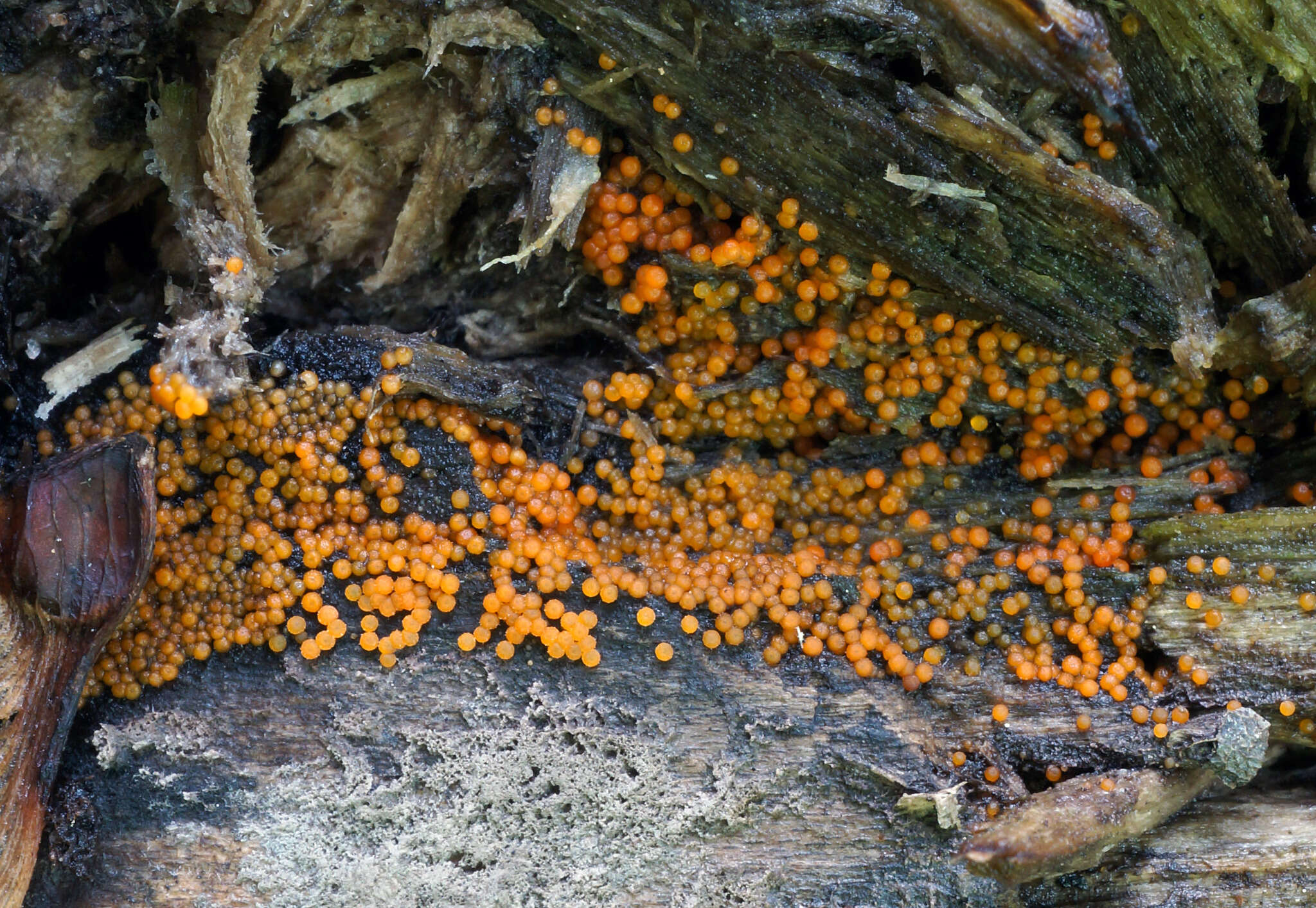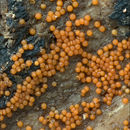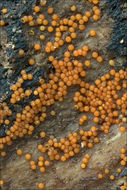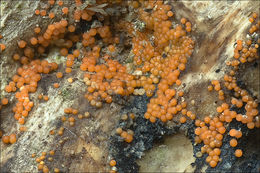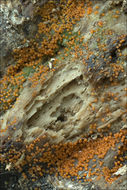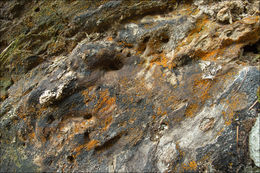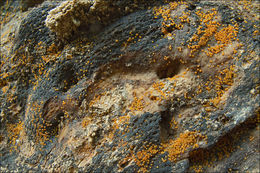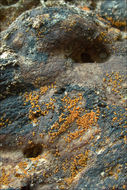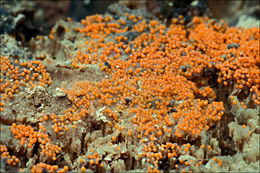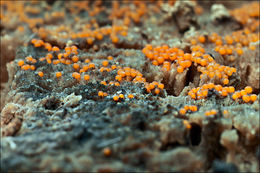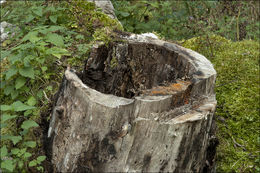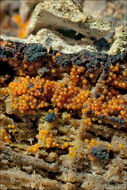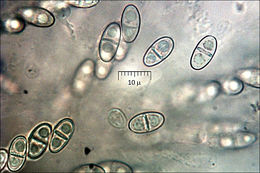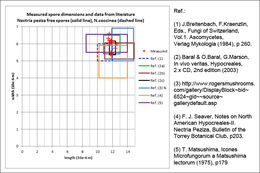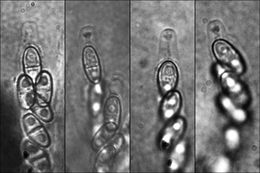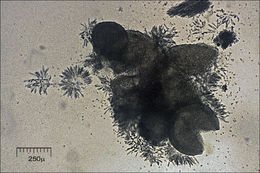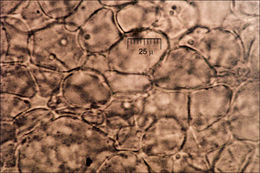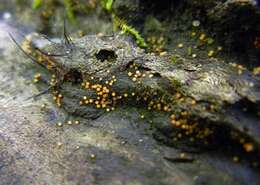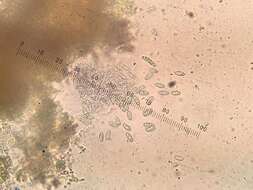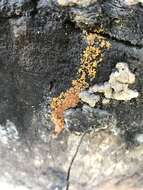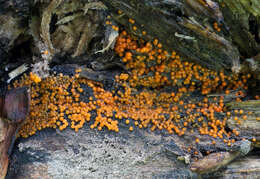-

Slo.: vrsta bradavike - syn.: Sphaeria peziza Tode, Neuronectria peziza (Tode) Munk - Habitat: Mixed wood, dominant Fagus sylvatica, Picea abies, Pinus sp., Larix decidua, Ostrya carpinifolia, Fraxinus ornus; moderately inclined mountain slope, south aspect, calcareous bedrock; rather dry and warm place, partly in shade, partly protected from direct rain by tree canopies, average precipitations ~ 3.000 mm/year, average temperature 5-7 deg C, elevation 890 m (2.900 feet), alpine phytogeographical region.Substratum: dead trunk of a large Fagus sylvatica in its last stage of disintegration.Comments: Growing in large colony with hundreds of fruitbodies. No microscopy done.Ref.:(1) J. Breitenbach, F. Kraenzlin, Eds., Fungi of Switzerland, Vol.1. Ascomycetes, Verlag Mykologia (1984), p 260.(2) H.O. Baral & O. Baral, G. Marson, In vivo veritas, Hypocreales, 2xCD, 2nd edition (2003)(3) http://www.rogersmushrooms.com/gallery/DisplayBlock~bid~6524~gid~~source~gallerydefault.asp(4) F. J. Seaver, Notes on North American Hypocreales-II. Nectria Peziza, Bulletin of the Torrey Botanical Club, p203. (available at http://www.jstor.org/stable/2479115?seq=3 ) (5) T. Matsushima, Icones Microfungorum a Matsushima lectorum(1975), p179 (available at http://www.mycobank.org ) (6) L. Hagar, Ottova Encyklopedia Hb, Ottova Nakladatelstvi, Praha (2015) (in Slovakian), p 116.
-
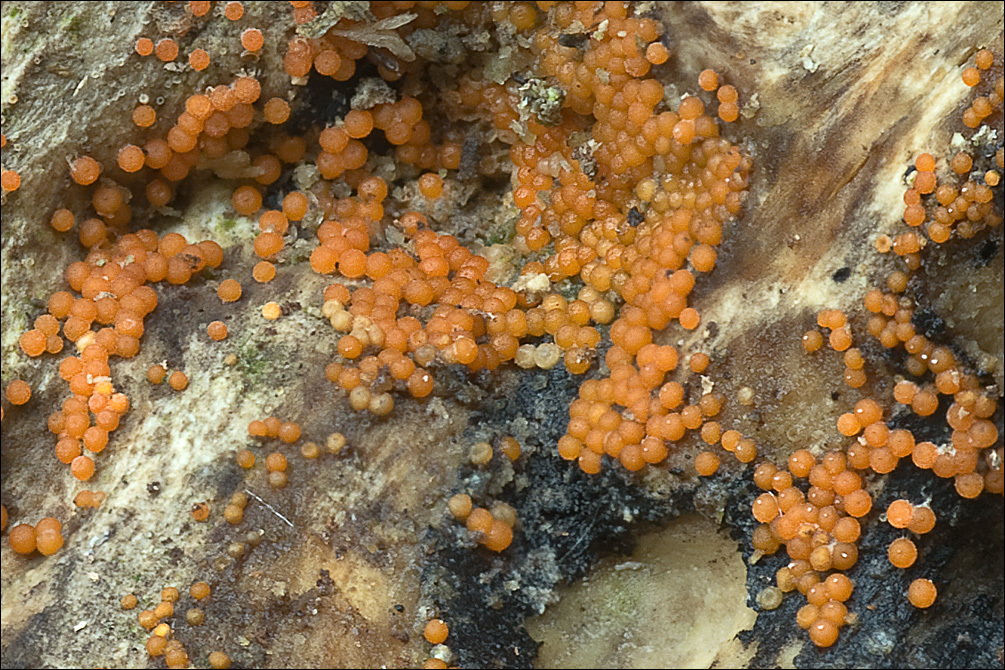
Slo.: vrsta bradavike - syn.: Sphaeria peziza Tode, Neuronectria peziza (Tode) Munk - Habitat: Mixed wood, dominant Fagus sylvatica, Picea abies, Pinus sp., Larix decidua, Ostrya carpinifolia, Fraxinus ornus; moderately inclined mountain slope, south aspect, calcareous bedrock; rather dry and warm place, partly in shade, partly protected from direct rain by tree canopies, average precipitations ~ 3.000 mm/year, average temperature 5-7 deg C, elevation 890 m (2.900 feet), alpine phytogeographical region. Substratum: dead trunk of a large Fagus sylvatica in its last stage of disintegration. Comments: Growing in large colony with hundreds of fruitbodies. No microscopy done. Ref.: (1) J. Breitenbach, F. Kraenzlin, Eds., Fungi of Switzerland, Vol.1. Ascomycetes, Verlag Mykologia (1984), p 260. (2) H.O. Baral & O. Baral, G. Marson, In vivo veritas, Hypocreales, 2xCD, 2nd edition (2003) (3) http://www.rogersmushrooms.com/gallery/DisplayBlock~bid~6524~gid~~source~gallerydefault.asp (4) F. J. Seaver, Notes on North American Hypocreales-II. Nectria Peziza, Bulletin of the Torrey Botanical Club, p203. (available at http://www.jstor.org/stable/2479115?seq=3 ) (5) T. Matsushima, Icones Microfungorum a Matsushima lectorum(1975), p179 (available at http://www.mycobank.org ) (6) L. Hagar, Ottova Encyklopedia Hb, Ottova Nakladatelstvi, Praha (2015) (in Slovakian), p 116.
-

Slo.: vrsta bradavike - syn.: Sphaeria peziza Tode, Neuronectria peziza (Tode) Munk - Habitat: Mixed wood, dominant Fagus sylvatica, Picea abies, Pinus sp., Larix decidua, Ostrya carpinifolia, Fraxinus ornus; moderately inclined mountain slope, south aspect, calcareous bedrock; rather dry and warm place, partly in shade, partly protected from direct rain by tree canopies, average precipitations ~ 3.000 mm/year, average temperature 5-7 deg C, elevation 890 m (2.900 feet), alpine phytogeographical region. Substratum: dead trunk of a large Fagus sylvatica in its last stage of disintegration. Comments: Growing in large colony with hundreds of fruitbodies. No microscopy done. Ref.: (1) J. Breitenbach, F. Kraenzlin, Eds., Fungi of Switzerland, Vol.1. Ascomycetes, Verlag Mykologia (1984), p 260. (2) H.O. Baral & O. Baral, G. Marson, In vivo veritas, Hypocreales, 2xCD, 2nd edition (2003) (3) http://www.rogersmushrooms.com/gallery/DisplayBlock~bid~6524~gid~~source~gallerydefault.asp (4) F. J. Seaver, Notes on North American Hypocreales-II. Nectria Peziza, Bulletin of the Torrey Botanical Club, p203. (available at http://www.jstor.org/stable/2479115?seq=3 ) (5) T. Matsushima, Icones Microfungorum a Matsushima lectorum(1975), p179 (available at http://www.mycobank.org ) (6) L. Hagar, Ottova Encyklopedia Hb, Ottova Nakladatelstvi, Praha (2015) (in Slovakian), p 116.
-

Slo.: vrsta bradavike - syn.: Sphaeria peziza Tode, Neuronectria peziza (Tode) Munk - Habitat: Mixed wood, dominant Fagus sylvatica, Picea abies, Pinus sp., Larix decidua, Ostrya carpinifolia, Fraxinus ornus; moderately inclined mountain slope, south aspect, calcareous bedrock; rather dry and warm place, partly in shade, partly protected from direct rain by tree canopies, average precipitations ~ 3.000 mm/year, average temperature 5-7 deg C, elevation 890 m (2.900 feet), alpine phytogeographical region. Substratum: dead trunk of a large Fagus sylvatica in its last stage of disintegration. Comments: Growing in large colony with hundreds of fruitbodies. No microscopy done. Ref.: (1) J. Breitenbach, F. Kraenzlin, Eds., Fungi of Switzerland, Vol.1. Ascomycetes, Verlag Mykologia (1984), p 260. (2) H.O. Baral & O. Baral, G. Marson, In vivo veritas, Hypocreales, 2xCD, 2nd edition (2003) (3) http://www.rogersmushrooms.com/gallery/DisplayBlock~bid~6524~gid~~source~gallerydefault.asp (4) F. J. Seaver, Notes on North American Hypocreales-II. Nectria Peziza, Bulletin of the Torrey Botanical Club, p203. (available at http://www.jstor.org/stable/2479115?seq=3 ) (5) T. Matsushima, Icones Microfungorum a Matsushima lectorum(1975), p179 (available at http://www.mycobank.org ) (6) L. Hagar, Ottova Encyklopedia Hb, Ottova Nakladatelstvi, Praha (2015) (in Slovakian), p 116.
-
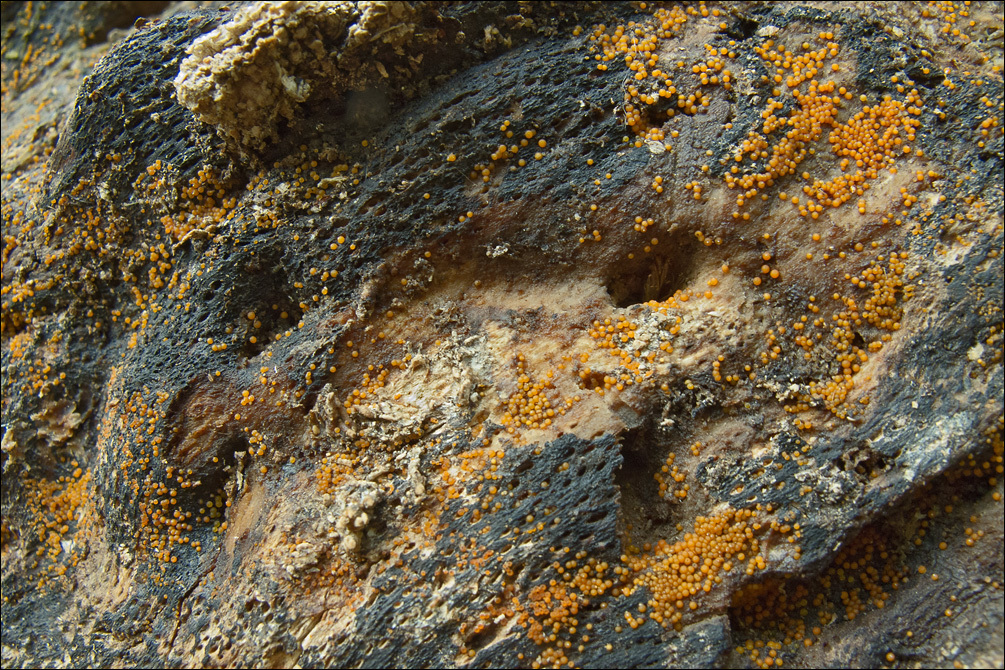
Slo.: vrsta bradavike - syn.: Sphaeria peziza Tode, Neuronectria peziza (Tode) Munk - Habitat: Mixed wood, dominant Fagus sylvatica, Picea abies, Pinus sp., Larix decidua, Ostrya carpinifolia, Fraxinus ornus; moderately inclined mountain slope, south aspect, calcareous bedrock; rather dry and warm place, partly in shade, partly protected from direct rain by tree canopies, average precipitations ~ 3.000 mm/year, average temperature 5-7 deg C, elevation 890 m (2.900 feet), alpine phytogeographical region. Substratum: dead trunk of a large Fagus sylvatica in its last stage of disintegration. Comments: Growing in large colony with hundreds of fruitbodies. No microscopy done. Ref.: (1) J. Breitenbach, F. Kraenzlin, Eds., Fungi of Switzerland, Vol.1. Ascomycetes, Verlag Mykologia (1984), p 260. (2) H.O. Baral & O. Baral, G. Marson, In vivo veritas, Hypocreales, 2xCD, 2nd edition (2003) (3) http://www.rogersmushrooms.com/gallery/DisplayBlock~bid~6524~gid~~source~gallerydefault.asp (4) F. J. Seaver, Notes on North American Hypocreales-II. Nectria Peziza, Bulletin of the Torrey Botanical Club, p203. (available at http://www.jstor.org/stable/2479115?seq=3 ) (5) T. Matsushima, Icones Microfungorum a Matsushima lectorum(1975), p179 (available at http://www.mycobank.org ) (6) L. Hagar, Ottova Encyklopedia Hb, Ottova Nakladatelstvi, Praha (2015) (in Slovakian), p 116.
-
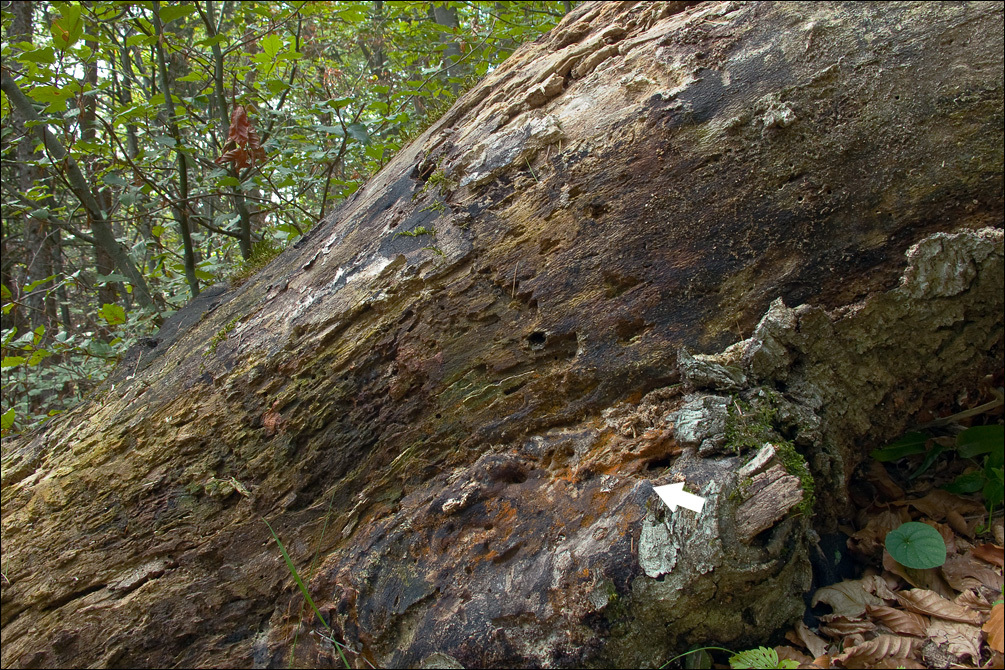
Slo.: vrsta bradavike - syn.: Sphaeria peziza Tode, Neuronectria peziza (Tode) Munk - Habitat: Mixed wood, dominant Fagus sylvatica, Picea abies, Pinus sp., Larix decidua, Ostrya carpinifolia, Fraxinus ornus; moderately inclined mountain slope, south aspect, calcareous bedrock; rather dry and warm place, partly in shade, partly protected from direct rain by tree canopies, average precipitations ~ 3.000 mm/year, average temperature 5-7 deg C, elevation 890 m (2.900 feet), alpine phytogeographical region. Substratum: dead trunk of a large Fagus sylvatica in its last stage of disintegration. Comments: Growing in large colony with hundreds of fruitbodies. No microscopy done. Ref.: (1) J. Breitenbach, F. Kraenzlin, Eds., Fungi of Switzerland, Vol.1. Ascomycetes, Verlag Mykologia (1984), p 260. (2) H.O. Baral & O. Baral, G. Marson, In vivo veritas, Hypocreales, 2xCD, 2nd edition (2003) (3) http://www.rogersmushrooms.com/gallery/DisplayBlock~bid~6524~gid~~source~gallerydefault.asp (4) F. J. Seaver, Notes on North American Hypocreales-II. Nectria Peziza, Bulletin of the Torrey Botanical Club, p203. (available at http://www.jstor.org/stable/2479115?seq=3 ) (5) T. Matsushima, Icones Microfungorum a Matsushima lectorum(1975), p179 (available at http://www.mycobank.org ) (6) L. Hagar, Ottova Encyklopedia Hb, Ottova Nakladatelstvi, Praha (2015) (in Slovakian), p 116.
-
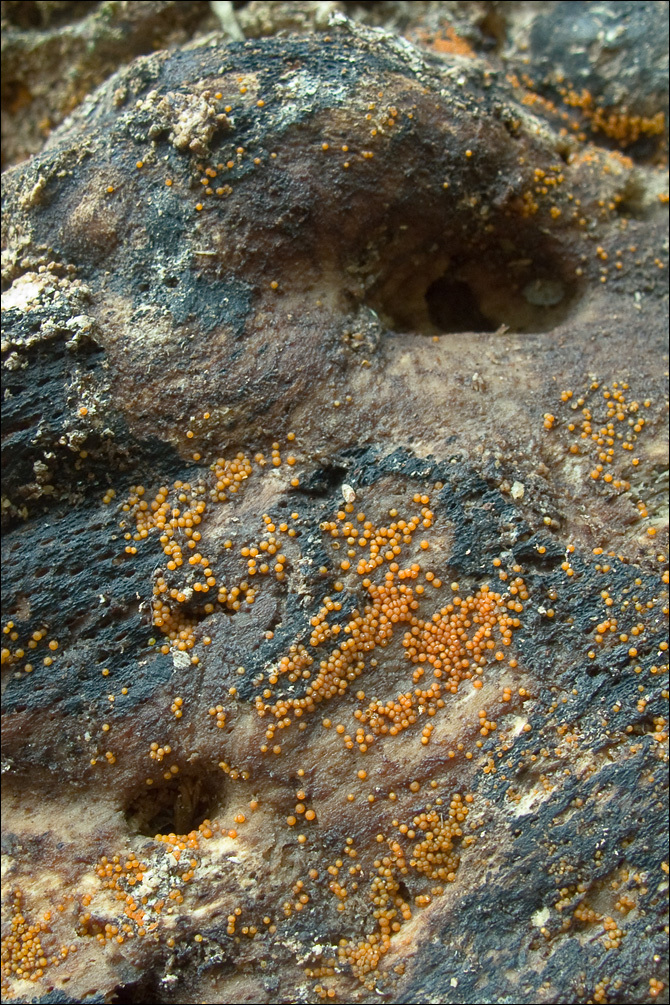
Slo.: vrsta bradavike - syn.: Sphaeria peziza Tode, Neuronectria peziza (Tode) Munk - Habitat: Mixed wood, dominant Fagus sylvatica, Picea abies, Pinus sp., Larix decidua, Ostrya carpinifolia, Fraxinus ornus; moderately inclined mountain slope, south aspect, calcareous bedrock; rather dry and warm place, partly in shade, partly protected from direct rain by tree canopies, average precipitations ~ 3.000 mm/year, average temperature 5-7 deg C, elevation 890 m (2.900 feet), alpine phytogeographical region. Substratum: dead trunk of a large Fagus sylvatica in its last stage of disintegration. Comments: Growing in large colony with hundreds of fruitbodies. No microscopy done. Ref.: (1) J. Breitenbach, F. Kraenzlin, Eds., Fungi of Switzerland, Vol.1. Ascomycetes, Verlag Mykologia (1984), p 260. (2) H.O. Baral & O. Baral, G. Marson, In vivo veritas, Hypocreales, 2xCD, 2nd edition (2003) (3) http://www.rogersmushrooms.com/gallery/DisplayBlock~bid~6524~gid~~source~gallerydefault.asp (4) F. J. Seaver, Notes on North American Hypocreales-II. Nectria Peziza, Bulletin of the Torrey Botanical Club, p203. (available at http://www.jstor.org/stable/2479115?seq=3 ) (5) T. Matsushima, Icones Microfungorum a Matsushima lectorum(1975), p179 (available at http://www.mycobank.org ) (6) L. Hagar, Ottova Encyklopedia Hb, Ottova Nakladatelstvi, Praha (2015) (in Slovakian), p 116.
-
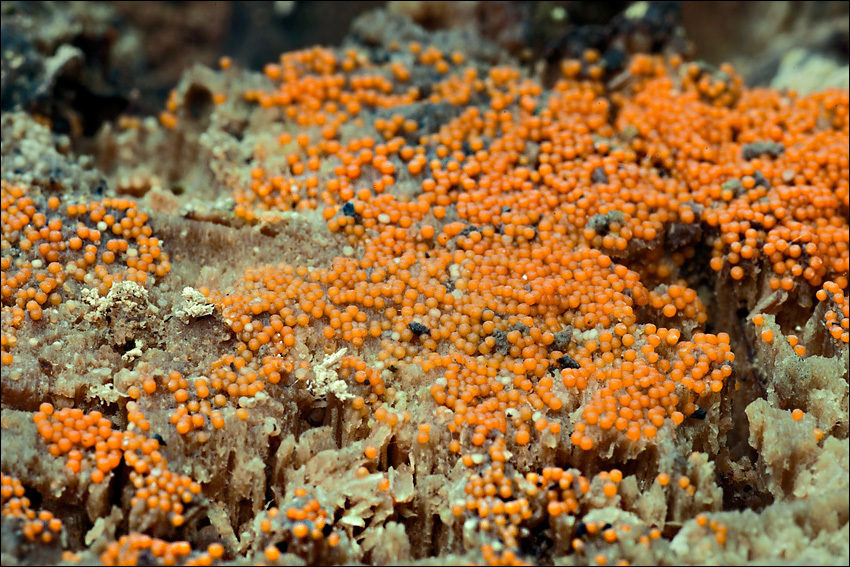
Habitat: Path side surrounded by pastures and mixed wood, near a farm house, locally flat terrain on southeast oriented mountain slope, open place, half sunny, mixed overgrown old scree and alluvial deposits, calcareous ground, exposed to direct rain, average precipitations ~ 3.000 mm/year, average temperature 7-9 deg C, elevation 560 m (1.850 feet), alpine phytogeographical region. - Substratum: old, debarked, hollow stump of a cut down Juglans regia in its final stage of disintegration. - Comments: First I thought this is a myxomicete, however, microscope immediately revealed that it belongs to ascomycetes. Two species (within the scope of the literature available to me) Nectria peziza and Nectria coccinea were the closest candidates. Based on fruit body size, ostioles and oil drops N. peziza seems a better fit. - Fruit body diameter: 0.39 (SD = 0.04) mm, n = 15 (in Ref.: (2) two observations cited: 0.34 mm and 0.3 to 0.5 mm). Ostioles clearly visible. Spores are septated and not warty. When observed slightly out of focus, longitudinal groves are barely visible on some (with my equipment), very slightly constricted, always with two large oil drops. Dimensions of free spores: 11.9(SD = 0.3) x 6.0 (SD = 0.14) μ, Q= 2.00 (SD = 0.14), n= 15. Dimensions of spores measured within asci: 11.7 (SD = 0.9) x 6.2 (SD = 0.5) μ, Q = 1.91 (SD = 0.24), n = 20, (data from Ref.: (2): 11.9 (SD = 1.1) x 5.9 (SD = 0.5) μ, n = 7). Asci dimensions: 88.1 (SD = 10.3) x 9.6 (SD = 1.0) μ, n = 9, (data from Ref.: (2): 70 - 90/7-9 μ; in Ref.:(1) = 60 - 80/7-10 μ). Olympus CH20 NEA 100x/1.25, magnification 1.000 x, oil (pictures of spores, apical ring), NEA 40x/0.65, magnification 400x (asci, trama), Bausch & Lomb 4x/0.10, magnification 40x (perithecia), in water. AmScope MA500 digital camera. - Herbarium: Mycotheca and lichen herbarium (LJU-Li) of Slovenian Forestry Institute, Večna pot 2, Ljubljana, Index Herbariorum LJF - Ref.: (1) J. Breitenbach, F. Kraenzlin, Eds., Fungi of Switzerland, Vol.1. Ascomycetes, Verlag Mykologia (1984), p 260. (2) H.O. Baral & O. Baral, G. Marson, In vivo veritas, Hypocreales, 2xCD, 2nd edition (2003) (3) http://www.rogersmushrooms.com/gallery/DisplayBlock~bid~6524~gid~~source~gallerydefault.asp (4) F. J. Seaver, Notes on North American Hypocreales-II. Nectria Peziza, Bulletin of the Torrey Botanical Club, p203. (available at http://www.jstor.org/stable/2479115?seq=3 ) 5) T. Matsushima, Icones Microfungorum a Matsushima lectorum(1975), p179 (available at http://www.mycobank.org )
-

Habitat: Path side surrounded by pastures and mixed wood, near a farm house, locally flat terrain on southeast oriented mountain slope, open place, half sunny, mixed overgrown old scree and alluvial deposits, calcareous ground, exposed to direct rain, average precipitations ~ 3.000 mm/year, average temperature 7-9 deg C, elevation 560 m (1.850 feet), alpine phytogeographical region. - Substratum: old, debarked, hollow stump of a cut down Juglans regia in its final stage of disintegration. - Comments: First I thought this is a myxomicete, however, microscope immediately revealed that it belongs to ascomycetes. Two species (within the scope of the literature available to me) Nectria peziza and Nectria coccinea were the closest candidates. Based on fruit body size, ostioles and oil drops N. peziza seems a better fit. - Fruit body diameter: 0.39 (SD = 0.04) mm, n = 15 (in Ref.: (2) two observations cited: 0.34 mm and 0.3 to 0.5 mm). Ostioles clearly visible. Spores are septated and not warty. When observed slightly out of focus, longitudinal groves are barely visible on some (with my equipment), very slightly constricted, always with two large oil drops. Dimensions of free spores: 11.9(SD = 0.3) x 6.0 (SD = 0.14) μ, Q= 2.00 (SD = 0.14), n= 15. Dimensions of spores measured within asci: 11.7 (SD = 0.9) x 6.2 (SD = 0.5) μ, Q = 1.91 (SD = 0.24), n = 20, (data from Ref.: (2): 11.9 (SD = 1.1) x 5.9 (SD = 0.5) μ, n = 7). Asci dimensions: 88.1 (SD = 10.3) x 9.6 (SD = 1.0) μ, n = 9, (data from Ref.: (2): 70 - 90/7-9 μ; in Ref.:(1) = 60 - 80/7-10 μ). Olympus CH20 NEA 100x/1.25, magnification 1.000 x, oil (pictures of spores, apical ring), NEA 40x/0.65, magnification 400x (asci, trama), Bausch & Lomb 4x/0.10, magnification 40x (perithecia), in water. AmScope MA500 digital camera. - Herbarium: Mycotheca and lichen herbarium (LJU-Li) of Slovenian Forestry Institute, Večna pot 2, Ljubljana, Index Herbariorum LJF - Ref.: (1) J. Breitenbach, F. Kraenzlin, Eds., Fungi of Switzerland, Vol.1. Ascomycetes, Verlag Mykologia (1984), p 260. (2) H.O. Baral & O. Baral, G. Marson, In vivo veritas, Hypocreales, 2xCD, 2nd edition (2003) (3) http://www.rogersmushrooms.com/gallery/DisplayBlock~bid~6524~gid~~source~gallerydefault.asp (4) F. J. Seaver, Notes on North American Hypocreales-II. Nectria Peziza, Bulletin of the Torrey Botanical Club, p203. (available at http://www.jstor.org/stable/2479115?seq=3 ) 5) T. Matsushima, Icones Microfungorum a Matsushima lectorum(1975), p179 (available at http://www.mycobank.org )
-
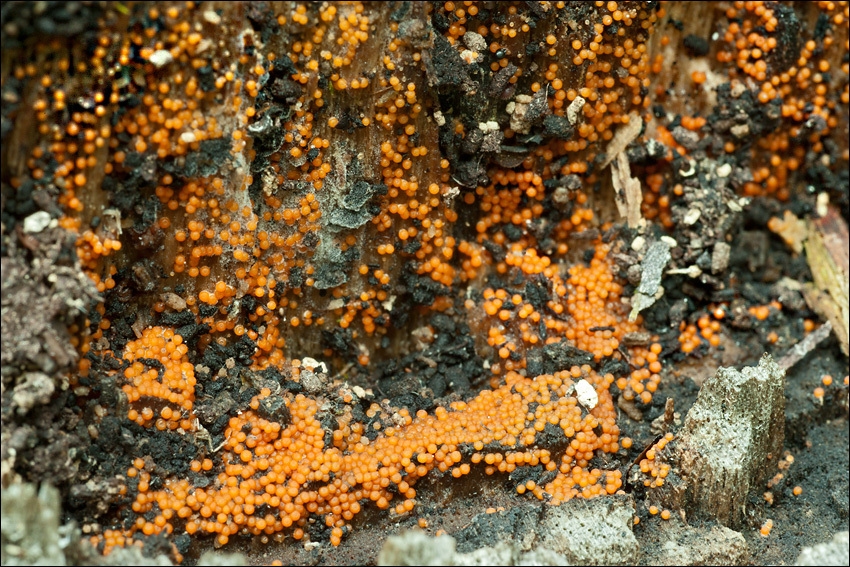
Habitat: Path side surrounded by pastures and mixed wood, near a farm house, locally flat terrain on southeast oriented mountain slope, open place, half sunny, mixed overgrown old scree and alluvial deposits, calcareous ground, exposed to direct rain, average precipitations ~ 3.000 mm/year, average temperature 7-9 deg C, elevation 560 m (1.850 feet), alpine phytogeographical region. - Substratum: old, debarked, hollow stump of a cut down Juglans regia in its final stage of disintegration. - Comments: First I thought this is a myxomicete, however, microscope immediately revealed that it belongs to ascomycetes. Two species (within the scope of the literature available to me) Nectria peziza and Nectria coccinea were the closest candidates. Based on fruit body size, ostioles and oil drops N. peziza seems a better fit. - Fruit body diameter: 0.39 (SD = 0.04) mm, n = 15 (in Ref.: (2) two observations cited: 0.34 mm and 0.3 to 0.5 mm). Ostioles clearly visible. Spores are septated and not warty. When observed slightly out of focus, longitudinal groves are barely visible on some (with my equipment), very slightly constricted, always with two large oil drops. Dimensions of free spores: 11.9(SD = 0.3) x 6.0 (SD = 0.14) μ, Q= 2.00 (SD = 0.14), n= 15. Dimensions of spores measured within asci: 11.7 (SD = 0.9) x 6.2 (SD = 0.5) μ, Q = 1.91 (SD = 0.24), n = 20, (data from Ref.: (2): 11.9 (SD = 1.1) x 5.9 (SD = 0.5) μ, n = 7). Asci dimensions: 88.1 (SD = 10.3) x 9.6 (SD = 1.0) μ, n = 9, (data from Ref.: (2): 70 - 90/7-9 μ; in Ref.:(1) = 60 - 80/7-10 μ). Olympus CH20 NEA 100x/1.25, magnification 1.000 x, oil (pictures of spores, apical ring), NEA 40x/0.65, magnification 400x (asci, trama), Bausch & Lomb 4x/0.10, magnification 40x (perithecia), in water. AmScope MA500 digital camera. - Herbarium: Mycotheca and lichen herbarium (LJU-Li) of Slovenian Forestry Institute, Večna pot 2, Ljubljana, Index Herbariorum LJF - Ref.: (1) J. Breitenbach, F. Kraenzlin, Eds., Fungi of Switzerland, Vol.1. Ascomycetes, Verlag Mykologia (1984), p 260. (2) H.O. Baral & O. Baral, G. Marson, In vivo veritas, Hypocreales, 2xCD, 2nd edition (2003) (3) http://www.rogersmushrooms.com/gallery/DisplayBlock~bid~6524~gid~~source~gallerydefault.asp (4) F. J. Seaver, Notes on North American Hypocreales-II. Nectria Peziza, Bulletin of the Torrey Botanical Club, p203. (available at http://www.jstor.org/stable/2479115?seq=3 ) 5) T. Matsushima, Icones Microfungorum a Matsushima lectorum(1975), p179 (available at http://www.mycobank.org )
-
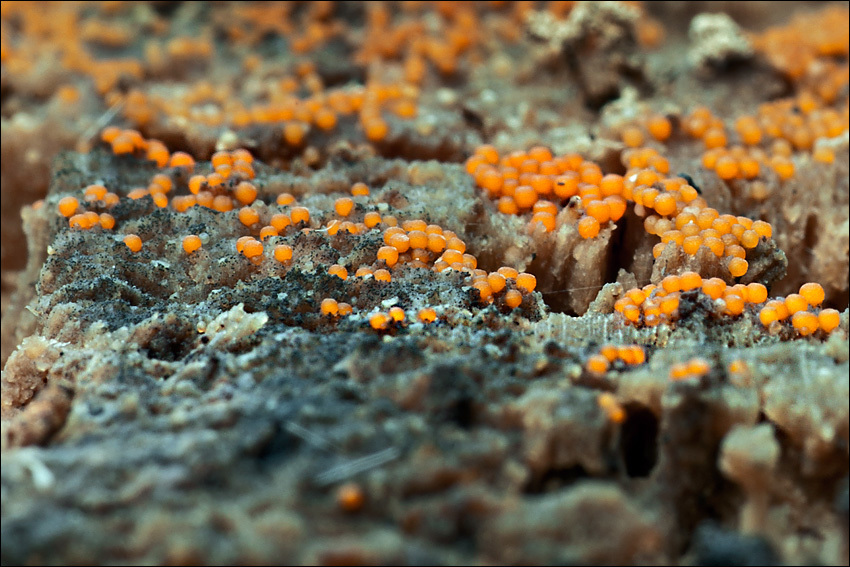
Habitat: Path side surrounded by pastures and mixed wood, near a farm house, locally flat terrain on southeast oriented mountain slope, open place, half sunny, mixed overgrown old scree and alluvial deposits, calcareous ground, exposed to direct rain, average precipitations ~ 3.000 mm/year, average temperature 7-9 deg C, elevation 560 m (1.850 feet), alpine phytogeographical region. - Substratum: old, debarked, hollow stump of a cut down Juglans regia in its final stage of disintegration. - Comments: First I thought this is a myxomicete, however, microscope immediately revealed that it belongs to ascomycetes. Two species (within the scope of the literature available to me) Nectria peziza and Nectria coccinea were the closest candidates. Based on fruit body size, ostioles and oil drops N. peziza seems a better fit. - Fruit body diameter: 0.39 (SD = 0.04) mm, n = 15 (in Ref.: (2) two observations cited: 0.34 mm and 0.3 to 0.5 mm). Ostioles clearly visible. Spores are septated and not warty. When observed slightly out of focus, longitudinal groves are barely visible on some (with my equipment), very slightly constricted, always with two large oil drops. Dimensions of free spores: 11.9(SD = 0.3) x 6.0 (SD = 0.14) μ, Q= 2.00 (SD = 0.14), n= 15. Dimensions of spores measured within asci: 11.7 (SD = 0.9) x 6.2 (SD = 0.5) μ, Q = 1.91 (SD = 0.24), n = 20, (data from Ref.: (2): 11.9 (SD = 1.1) x 5.9 (SD = 0.5) μ, n = 7). Asci dimensions: 88.1 (SD = 10.3) x 9.6 (SD = 1.0) μ, n = 9, (data from Ref.: (2): 70 - 90/7-9 μ; in Ref.:(1) = 60 - 80/7-10 μ). Olympus CH20 NEA 100x/1.25, magnification 1.000 x, oil (pictures of spores, apical ring), NEA 40x/0.65, magnification 400x (asci, trama), Bausch & Lomb 4x/0.10, magnification 40x (perithecia), in water. AmScope MA500 digital camera. - Herbarium: Mycotheca and lichen herbarium (LJU-Li) of Slovenian Forestry Institute, Večna pot 2, Ljubljana, Index Herbariorum LJF - Ref.: (1) J. Breitenbach, F. Kraenzlin, Eds., Fungi of Switzerland, Vol.1. Ascomycetes, Verlag Mykologia (1984), p 260. (2) H.O. Baral & O. Baral, G. Marson, In vivo veritas, Hypocreales, 2xCD, 2nd edition (2003) (3) http://www.rogersmushrooms.com/gallery/DisplayBlock~bid~6524~gid~~source~gallerydefault.asp (4) F. J. Seaver, Notes on North American Hypocreales-II. Nectria Peziza, Bulletin of the Torrey Botanical Club, p203. (available at http://www.jstor.org/stable/2479115?seq=3 ) 5) T. Matsushima, Icones Microfungorum a Matsushima lectorum(1975), p179 (available at http://www.mycobank.org )
-
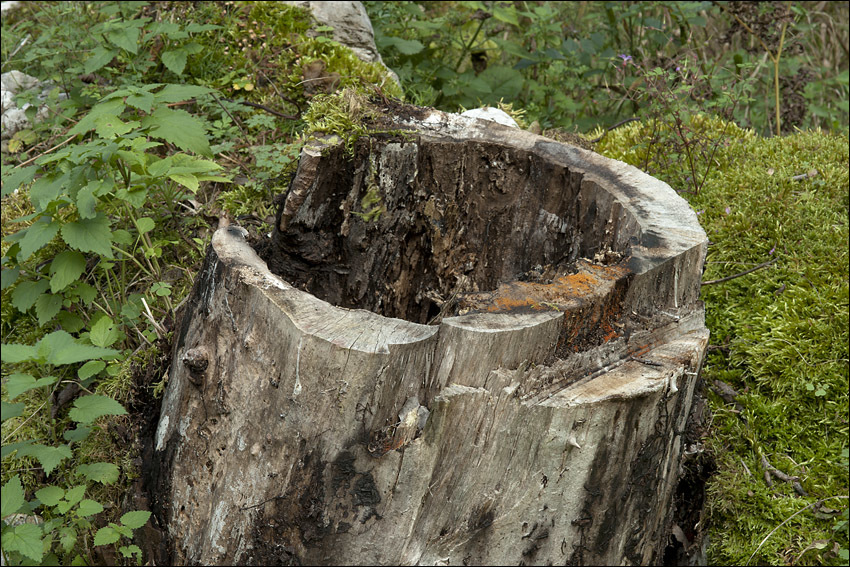
Habitat: Path side surrounded by pastures and mixed wood, near a farm house, locally flat terrain on southeast oriented mountain slope, open place, half sunny, mixed overgrown old scree and alluvial deposits, calcareous ground, exposed to direct rain, average precipitations ~ 3.000 mm/year, average temperature 7-9 deg C, elevation 560 m (1.850 feet), alpine phytogeographical region. - Substratum: old, debarked, hollow stump of a cut down Juglans regia in its final stage of disintegration. - Comments: First I thought this is a myxomicete, however, microscope immediately revealed that it belongs to ascomycetes. Two species (within the scope of the literature available to me) Nectria peziza and Nectria coccinea were the closest candidates. Based on fruit body size, ostioles and oil drops N. peziza seems a better fit. - Fruit body diameter: 0.39 (SD = 0.04) mm, n = 15 (in Ref.: (2) two observations cited: 0.34 mm and 0.3 to 0.5 mm). Ostioles clearly visible. Spores are septated and not warty. When observed slightly out of focus, longitudinal groves are barely visible on some (with my equipment), very slightly constricted, always with two large oil drops. Dimensions of free spores: 11.9(SD = 0.3) x 6.0 (SD = 0.14) μ, Q= 2.00 (SD = 0.14), n= 15. Dimensions of spores measured within asci: 11.7 (SD = 0.9) x 6.2 (SD = 0.5) μ, Q = 1.91 (SD = 0.24), n = 20, (data from Ref.: (2): 11.9 (SD = 1.1) x 5.9 (SD = 0.5) μ, n = 7). Asci dimensions: 88.1 (SD = 10.3) x 9.6 (SD = 1.0) μ, n = 9, (data from Ref.: (2): 70 - 90/7-9 μ; in Ref.:(1) = 60 - 80/7-10 μ). Olympus CH20 NEA 100x/1.25, magnification 1.000 x, oil (pictures of spores, apical ring), NEA 40x/0.65, magnification 400x (asci, trama), Bausch & Lomb 4x/0.10, magnification 40x (perithecia), in water. AmScope MA500 digital camera. - Herbarium: Mycotheca and lichen herbarium (LJU-Li) of Slovenian Forestry Institute, Večna pot 2, Ljubljana, Index Herbariorum LJF - Ref.: (1) J. Breitenbach, F. Kraenzlin, Eds., Fungi of Switzerland, Vol.1. Ascomycetes, Verlag Mykologia (1984), p 260. (2) H.O. Baral & O. Baral, G. Marson, In vivo veritas, Hypocreales, 2xCD, 2nd edition (2003) (3) http://www.rogersmushrooms.com/gallery/DisplayBlock~bid~6524~gid~~source~gallerydefault.asp (4) F. J. Seaver, Notes on North American Hypocreales-II. Nectria Peziza, Bulletin of the Torrey Botanical Club, p203. (available at http://www.jstor.org/stable/2479115?seq=3 ) 5) T. Matsushima, Icones Microfungorum a Matsushima lectorum(1975), p179 (available at http://www.mycobank.org )
-
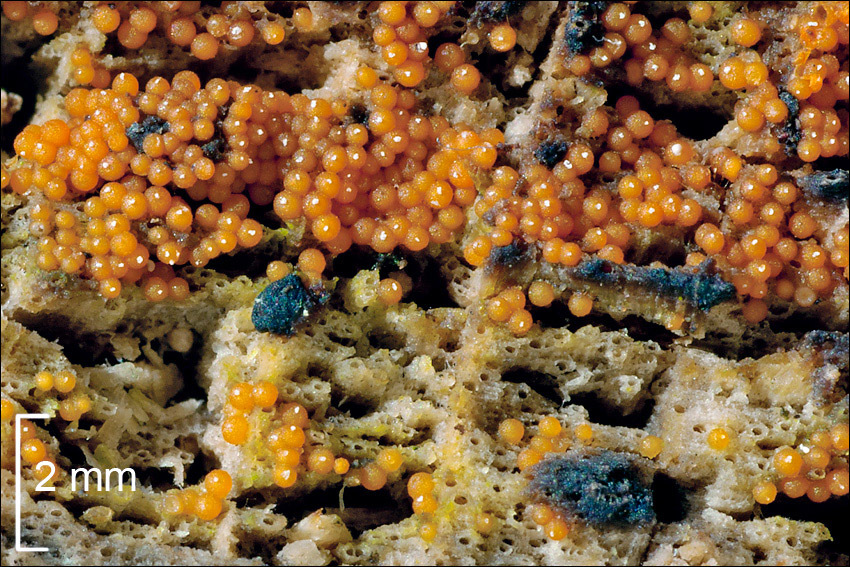
Habitat: Path side surrounded by pastures and mixed wood, near a farm house, locally flat terrain on southeast oriented mountain slope, open place, half sunny, mixed overgrown old scree and alluvial deposits, calcareous ground, exposed to direct rain, average precipitations ~ 3.000 mm/year, average temperature 7-9 deg C, elevation 560 m (1.850 feet), alpine phytogeographical region. - Substratum: old, debarked, hollow stump of a cut down Juglans regia in its final stage of disintegration. - Comments: First I thought this is a myxomicete, however, microscope immediately revealed that it belongs to ascomycetes. Two species (within the scope of the literature available to me) Nectria peziza and Nectria coccinea were the closest candidates. Based on fruit body size, ostioles and oil drops N. peziza seems a better fit. - Fruit body diameter: 0.39 (SD = 0.04) mm, n = 15 (in Ref.: (2) two observations cited: 0.34 mm and 0.3 to 0.5 mm). Ostioles clearly visible. Spores are septated and not warty. When observed slightly out of focus, longitudinal groves are barely visible on some (with my equipment), very slightly constricted, always with two large oil drops. Dimensions of free spores: 11.9(SD = 0.3) x 6.0 (SD = 0.14) μ, Q= 2.00 (SD = 0.14), n= 15. Dimensions of spores measured within asci: 11.7 (SD = 0.9) x 6.2 (SD = 0.5) μ, Q = 1.91 (SD = 0.24), n = 20, (data from Ref.: (2): 11.9 (SD = 1.1) x 5.9 (SD = 0.5) μ, n = 7). Asci dimensions: 88.1 (SD = 10.3) x 9.6 (SD = 1.0) μ, n = 9, (data from Ref.: (2): 70 - 90/7-9 μ; in Ref.:(1) = 60 - 80/7-10 μ). Olympus CH20 NEA 100x/1.25, magnification 1.000 x, oil (pictures of spores, apical ring), NEA 40x/0.65, magnification 400x (asci, trama), Bausch & Lomb 4x/0.10, magnification 40x (perithecia), in water. AmScope MA500 digital camera. - Herbarium: Mycotheca and lichen herbarium (LJU-Li) of Slovenian Forestry Institute, Večna pot 2, Ljubljana, Index Herbariorum LJF - Ref.: (1) J. Breitenbach, F. Kraenzlin, Eds., Fungi of Switzerland, Vol.1. Ascomycetes, Verlag Mykologia (1984), p 260. (2) H.O. Baral & O. Baral, G. Marson, In vivo veritas, Hypocreales, 2xCD, 2nd edition (2003) (3) http://www.rogersmushrooms.com/gallery/DisplayBlock~bid~6524~gid~~source~gallerydefault.asp (4) F. J. Seaver, Notes on North American Hypocreales-II. Nectria Peziza, Bulletin of the Torrey Botanical Club, p203. (available at http://www.jstor.org/stable/2479115?seq=3 ) 5) T. Matsushima, Icones Microfungorum a Matsushima lectorum(1975), p179 (available at http://www.mycobank.org )
-
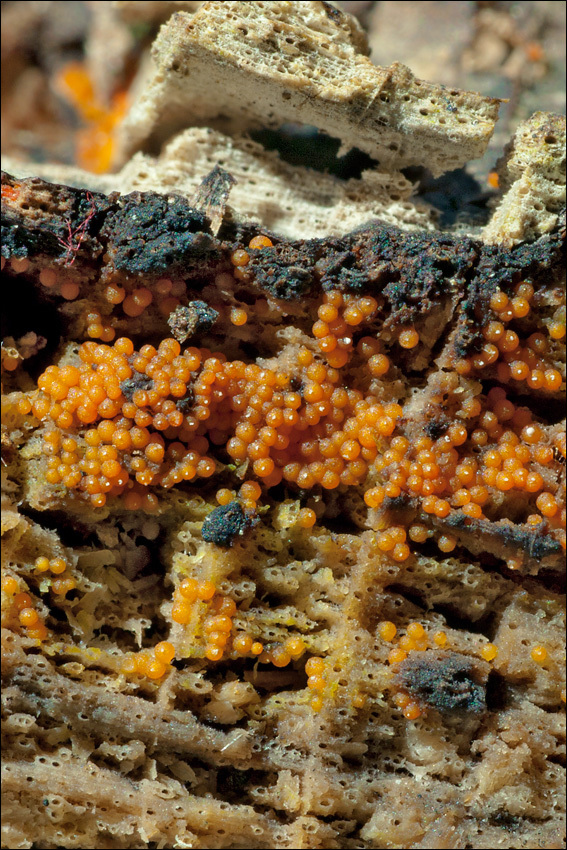
Habitat: Path side surrounded by pastures and mixed wood, near a farm house, locally flat terrain on southeast oriented mountain slope, open place, half sunny, mixed overgrown old scree and alluvial deposits, calcareous ground, exposed to direct rain, average precipitations ~ 3.000 mm/year, average temperature 7-9 deg C, elevation 560 m (1.850 feet), alpine phytogeographical region. - Substratum: old, debarked, hollow stump of a cut down Juglans regia in its final stage of disintegration. - Comments: First I thought this is a myxomicete, however, microscope immediately revealed that it belongs to ascomycetes. Two species (within the scope of the literature available to me) Nectria peziza and Nectria coccinea were the closest candidates. Based on fruit body size, ostioles and oil drops N. peziza seems a better fit. - Fruit body diameter: 0.39 (SD = 0.04) mm, n = 15 (in Ref.: (2) two observations cited: 0.34 mm and 0.3 to 0.5 mm). Ostioles clearly visible. Spores are septated and not warty. When observed slightly out of focus, longitudinal groves are barely visible on some (with my equipment), very slightly constricted, always with two large oil drops. Dimensions of free spores: 11.9(SD = 0.3) x 6.0 (SD = 0.14) μ, Q= 2.00 (SD = 0.14), n= 15. Dimensions of spores measured within asci: 11.7 (SD = 0.9) x 6.2 (SD = 0.5) μ, Q = 1.91 (SD = 0.24), n = 20, (data from Ref.: (2): 11.9 (SD = 1.1) x 5.9 (SD = 0.5) μ, n = 7). Asci dimensions: 88.1 (SD = 10.3) x 9.6 (SD = 1.0) μ, n = 9, (data from Ref.: (2): 70 - 90/7-9 μ; in Ref.:(1) = 60 - 80/7-10 μ). Olympus CH20 NEA 100x/1.25, magnification 1.000 x, oil (pictures of spores, apical ring), NEA 40x/0.65, magnification 400x (asci, trama), Bausch & Lomb 4x/0.10, magnification 40x (perithecia), in water. AmScope MA500 digital camera. - Herbarium: Mycotheca and lichen herbarium (LJU-Li) of Slovenian Forestry Institute, Večna pot 2, Ljubljana, Index Herbariorum LJF - Ref.: (1) J. Breitenbach, F. Kraenzlin, Eds., Fungi of Switzerland, Vol.1. Ascomycetes, Verlag Mykologia (1984), p 260. (2) H.O. Baral & O. Baral, G. Marson, In vivo veritas, Hypocreales, 2xCD, 2nd edition (2003) (3) http://www.rogersmushrooms.com/gallery/DisplayBlock~bid~6524~gid~~source~gallerydefault.asp (4) F. J. Seaver, Notes on North American Hypocreales-II. Nectria Peziza, Bulletin of the Torrey Botanical Club, p203. (available at http://www.jstor.org/stable/2479115?seq=3 ) 5) T. Matsushima, Icones Microfungorum a Matsushima lectorum(1975), p179 (available at http://www.mycobank.org )
-
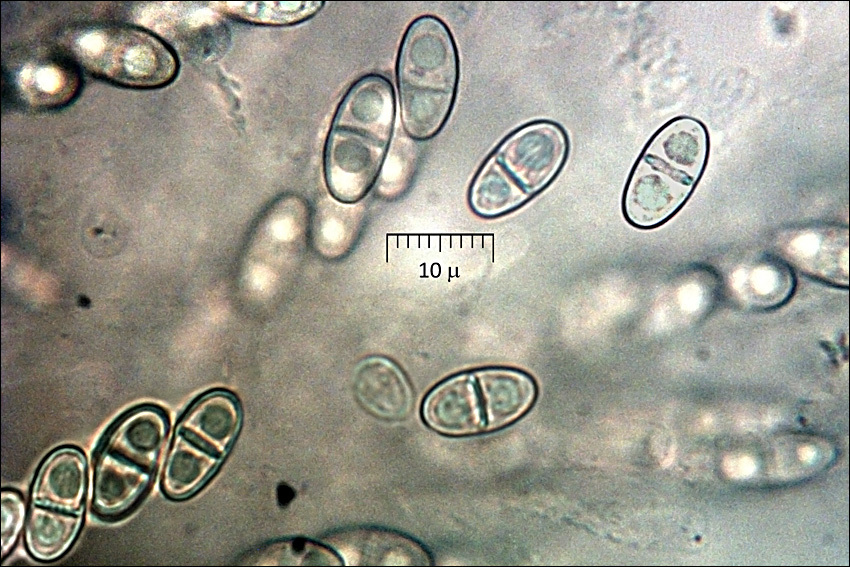
Habitat: Path side surrounded by pastures and mixed wood, near a farm house, locally flat terrain on southeast oriented mountain slope, open place, half sunny, mixed overgrown old scree and alluvial deposits, calcareous ground, exposed to direct rain, average precipitations ~ 3.000 mm/year, average temperature 7-9 deg C, elevation 560 m (1.850 feet), alpine phytogeographical region. - Substratum: old, debarked, hollow stump of a cut down Juglans regia in its final stage of disintegration. - Comments: First I thought this is a myxomicete, however, microscope immediately revealed that it belongs to ascomycetes. Two species (within the scope of the literature available to me) Nectria peziza and Nectria coccinea were the closest candidates. Based on fruit body size, ostioles and oil drops N. peziza seems a better fit. - Fruit body diameter: 0.39 (SD = 0.04) mm, n = 15 (in Ref.: (2) two observations cited: 0.34 mm and 0.3 to 0.5 mm). Ostioles clearly visible. Spores are septated and not warty. When observed slightly out of focus, longitudinal groves are barely visible on some (with my equipment), very slightly constricted, always with two large oil drops. Dimensions of free spores: 11.9(SD = 0.3) x 6.0 (SD = 0.14) μ, Q= 2.00 (SD = 0.14), n= 15. Dimensions of spores measured within asci: 11.7 (SD = 0.9) x 6.2 (SD = 0.5) μ, Q = 1.91 (SD = 0.24), n = 20, (data from Ref.: (2): 11.9 (SD = 1.1) x 5.9 (SD = 0.5) μ, n = 7). Asci dimensions: 88.1 (SD = 10.3) x 9.6 (SD = 1.0) μ, n = 9, (data from Ref.: (2): 70 - 90/7-9 μ; in Ref.:(1) = 60 - 80/7-10 μ). Olympus CH20 NEA 100x/1.25, magnification 1.000 x, oil (pictures of spores, apical ring), NEA 40x/0.65, magnification 400x (asci, trama), Bausch & Lomb 4x/0.10, magnification 40x (perithecia), in water. AmScope MA500 digital camera. - Herbarium: Mycotheca and lichen herbarium (LJU-Li) of Slovenian Forestry Institute, Večna pot 2, Ljubljana, Index Herbariorum LJF - Ref.: (1) J. Breitenbach, F. Kraenzlin, Eds., Fungi of Switzerland, Vol.1. Ascomycetes, Verlag Mykologia (1984), p 260. (2) H.O. Baral & O. Baral, G. Marson, In vivo veritas, Hypocreales, 2xCD, 2nd edition (2003) (3) http://www.rogersmushrooms.com/gallery/DisplayBlock~bid~6524~gid~~source~gallerydefault.asp (4) F. J. Seaver, Notes on North American Hypocreales-II. Nectria Peziza, Bulletin of the Torrey Botanical Club, p203. (available at http://www.jstor.org/stable/2479115?seq=3 ) 5) T. Matsushima, Icones Microfungorum a Matsushima lectorum(1975), p179 (available at http://www.mycobank.org )
-

Habitat: Path side surrounded by pastures and mixed wood, near a farm house, locally flat terrain on southeast oriented mountain slope, open place, half sunny, mixed overgrown old scree and alluvial deposits, calcareous ground, exposed to direct rain, average precipitations ~ 3.000 mm/year, average temperature 7-9 deg C, elevation 560 m (1.850 feet), alpine phytogeographical region. - Substratum: old, debarked, hollow stump of a cut down Juglans regia in its final stage of disintegration. - Comments: First I thought this is a myxomicete, however, microscope immediately revealed that it belongs to ascomycetes. Two species (within the scope of the literature available to me) Nectria peziza and Nectria coccinea were the closest candidates. Based on fruit body size, ostioles and oil drops N. peziza seems a better fit. - Fruit body diameter: 0.39 (SD = 0.04) mm, n = 15 (in Ref.: (2) two observations cited: 0.34 mm and 0.3 to 0.5 mm). Ostioles clearly visible. Spores are septated and not warty. When observed slightly out of focus, longitudinal groves are barely visible on some (with my equipment), very slightly constricted, always with two large oil drops. Dimensions of free spores: 11.9(SD = 0.3) x 6.0 (SD = 0.14) μ, Q= 2.00 (SD = 0.14), n= 15. Dimensions of spores measured within asci: 11.7 (SD = 0.9) x 6.2 (SD = 0.5) μ, Q = 1.91 (SD = 0.24), n = 20, (data from Ref.: (2): 11.9 (SD = 1.1) x 5.9 (SD = 0.5) μ, n = 7). Asci dimensions: 88.1 (SD = 10.3) x 9.6 (SD = 1.0) μ, n = 9, (data from Ref.: (2): 70 - 90/7-9 μ; in Ref.:(1) = 60 - 80/7-10 μ). Olympus CH20 NEA 100x/1.25, magnification 1.000 x, oil (pictures of spores, apical ring), NEA 40x/0.65, magnification 400x (asci, trama), Bausch & Lomb 4x/0.10, magnification 40x (perithecia), in water. AmScope MA500 digital camera. - Herbarium: Mycotheca and lichen herbarium (LJU-Li) of Slovenian Forestry Institute, Večna pot 2, Ljubljana, Index Herbariorum LJF - Ref.: (1) J. Breitenbach, F. Kraenzlin, Eds., Fungi of Switzerland, Vol.1. Ascomycetes, Verlag Mykologia (1984), p 260. (2) H.O. Baral & O. Baral, G. Marson, In vivo veritas, Hypocreales, 2xCD, 2nd edition (2003) (3) http://www.rogersmushrooms.com/gallery/DisplayBlock~bid~6524~gid~~source~gallerydefault.asp (4) F. J. Seaver, Notes on North American Hypocreales-II. Nectria Peziza, Bulletin of the Torrey Botanical Club, p203. (available at http://www.jstor.org/stable/2479115?seq=3 ) 5) T. Matsushima, Icones Microfungorum a Matsushima lectorum(1975), p179 (available at http://www.mycobank.org )
-
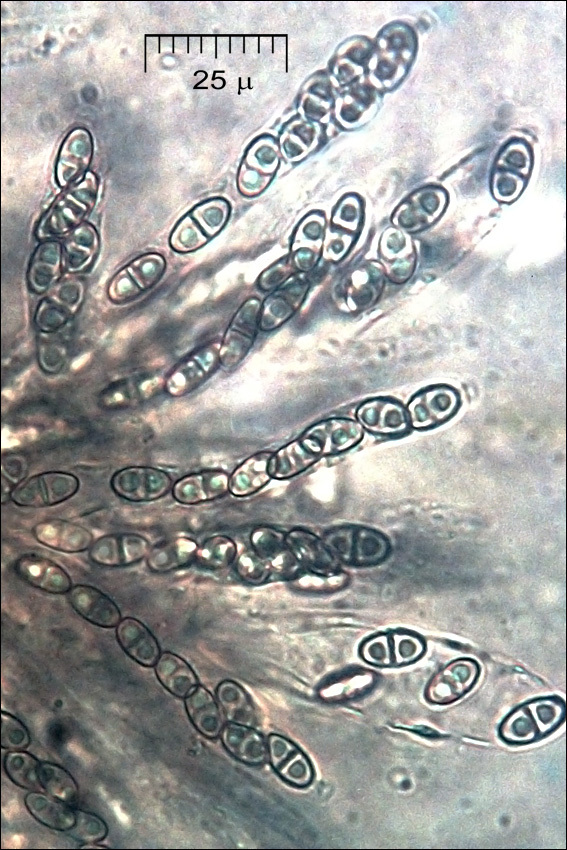
Habitat: Path side surrounded by pastures and mixed wood, near a farm house, locally flat terrain on southeast oriented mountain slope, open place, half sunny, mixed overgrown old scree and alluvial deposits, calcareous ground, exposed to direct rain, average precipitations ~ 3.000 mm/year, average temperature 7-9 deg C, elevation 560 m (1.850 feet), alpine phytogeographical region. - Substratum: old, debarked, hollow stump of a cut down Juglans regia in its final stage of disintegration. - Comments: First I thought this is a myxomicete, however, microscope immediately revealed that it belongs to ascomycetes. Two species (within the scope of the literature available to me) Nectria peziza and Nectria coccinea were the closest candidates. Based on fruit body size, ostioles and oil drops N. peziza seems a better fit. - Fruit body diameter: 0.39 (SD = 0.04) mm, n = 15 (in Ref.: (2) two observations cited: 0.34 mm and 0.3 to 0.5 mm). Ostioles clearly visible. Spores are septated and not warty. When observed slightly out of focus, longitudinal groves are barely visible on some (with my equipment), very slightly constricted, always with two large oil drops. Dimensions of free spores: 11.9(SD = 0.3) x 6.0 (SD = 0.14) μ, Q= 2.00 (SD = 0.14), n= 15. Dimensions of spores measured within asci: 11.7 (SD = 0.9) x 6.2 (SD = 0.5) μ, Q = 1.91 (SD = 0.24), n = 20, (data from Ref.: (2): 11.9 (SD = 1.1) x 5.9 (SD = 0.5) μ, n = 7). Asci dimensions: 88.1 (SD = 10.3) x 9.6 (SD = 1.0) μ, n = 9, (data from Ref.: (2): 70 - 90/7-9 μ; in Ref.:(1) = 60 - 80/7-10 μ). Olympus CH20 NEA 100x/1.25, magnification 1.000 x, oil (pictures of spores, apical ring), NEA 40x/0.65, magnification 400x (asci, trama), Bausch & Lomb 4x/0.10, magnification 40x (perithecia), in water. AmScope MA500 digital camera. - Herbarium: Mycotheca and lichen herbarium (LJU-Li) of Slovenian Forestry Institute, Večna pot 2, Ljubljana, Index Herbariorum LJF - Ref.: (1) J. Breitenbach, F. Kraenzlin, Eds., Fungi of Switzerland, Vol.1. Ascomycetes, Verlag Mykologia (1984), p 260. (2) H.O. Baral & O. Baral, G. Marson, In vivo veritas, Hypocreales, 2xCD, 2nd edition (2003) (3) http://www.rogersmushrooms.com/gallery/DisplayBlock~bid~6524~gid~~source~gallerydefault.asp (4) F. J. Seaver, Notes on North American Hypocreales-II. Nectria Peziza, Bulletin of the Torrey Botanical Club, p203. (available at http://www.jstor.org/stable/2479115?seq=3 ) 5) T. Matsushima, Icones Microfungorum a Matsushima lectorum(1975), p179 (available at http://www.mycobank.org )
-
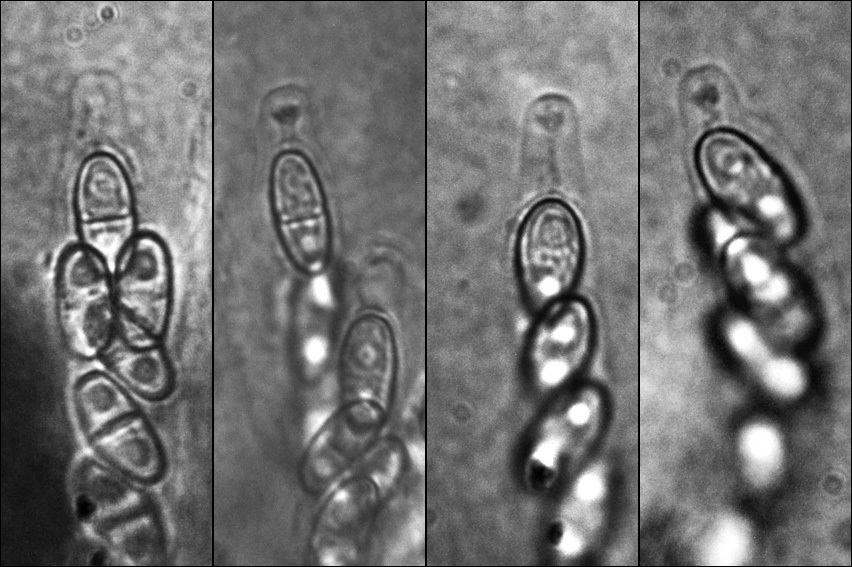
Habitat: Path side surrounded by pastures and mixed wood, near a farm house, locally flat terrain on southeast oriented mountain slope, open place, half sunny, mixed overgrown old scree and alluvial deposits, calcareous ground, exposed to direct rain, average precipitations ~ 3.000 mm/year, average temperature 7-9 deg C, elevation 560 m (1.850 feet), alpine phytogeographical region. - Substratum: old, debarked, hollow stump of a cut down Juglans regia in its final stage of disintegration. - Comments: First I thought this is a myxomicete, however, microscope immediately revealed that it belongs to ascomycetes. Two species (within the scope of the literature available to me) Nectria peziza and Nectria coccinea were the closest candidates. Based on fruit body size, ostioles and oil drops N. peziza seems a better fit. - Fruit body diameter: 0.39 (SD = 0.04) mm, n = 15 (in Ref.: (2) two observations cited: 0.34 mm and 0.3 to 0.5 mm). Ostioles clearly visible. Spores are septated and not warty. When observed slightly out of focus, longitudinal groves are barely visible on some (with my equipment), very slightly constricted, always with two large oil drops. Dimensions of free spores: 11.9(SD = 0.3) x 6.0 (SD = 0.14) μ, Q= 2.00 (SD = 0.14), n= 15. Dimensions of spores measured within asci: 11.7 (SD = 0.9) x 6.2 (SD = 0.5) μ, Q = 1.91 (SD = 0.24), n = 20, (data from Ref.: (2): 11.9 (SD = 1.1) x 5.9 (SD = 0.5) μ, n = 7). Asci dimensions: 88.1 (SD = 10.3) x 9.6 (SD = 1.0) μ, n = 9, (data from Ref.: (2): 70 - 90/7-9 μ; in Ref.:(1) = 60 - 80/7-10 μ). Olympus CH20 NEA 100x/1.25, magnification 1.000 x, oil (pictures of spores, apical ring), NEA 40x/0.65, magnification 400x (asci, trama), Bausch & Lomb 4x/0.10, magnification 40x (perithecia), in water. AmScope MA500 digital camera. - Herbarium: Mycotheca and lichen herbarium (LJU-Li) of Slovenian Forestry Institute, Večna pot 2, Ljubljana, Index Herbariorum LJF - Ref.: (1) J. Breitenbach, F. Kraenzlin, Eds., Fungi of Switzerland, Vol.1. Ascomycetes, Verlag Mykologia (1984), p 260. (2) H.O. Baral & O. Baral, G. Marson, In vivo veritas, Hypocreales, 2xCD, 2nd edition (2003) (3) http://www.rogersmushrooms.com/gallery/DisplayBlock~bid~6524~gid~~source~gallerydefault.asp (4) F. J. Seaver, Notes on North American Hypocreales-II. Nectria Peziza, Bulletin of the Torrey Botanical Club, p203. (available at http://www.jstor.org/stable/2479115?seq=3 ) 5) T. Matsushima, Icones Microfungorum a Matsushima lectorum(1975), p179 (available at http://www.mycobank.org )
-
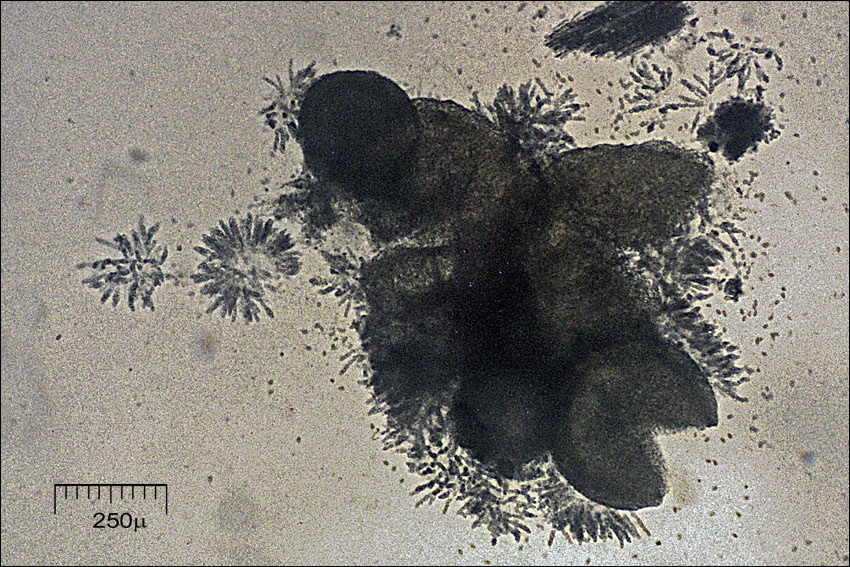
Habitat: Path side surrounded by pastures and mixed wood, near a farm house, locally flat terrain on southeast oriented mountain slope, open place, half sunny, mixed overgrown old scree and alluvial deposits, calcareous ground, exposed to direct rain, average precipitations ~ 3.000 mm/year, average temperature 7-9 deg C, elevation 560 m (1.850 feet), alpine phytogeographical region. - Substratum: old, debarked, hollow stump of a cut down Juglans regia in its final stage of disintegration. - Comments: First I thought this is a myxomicete, however, microscope immediately revealed that it belongs to ascomycetes. Two species (within the scope of the literature available to me) Nectria peziza and Nectria coccinea were the closest candidates. Based on fruit body size, ostioles and oil drops N. peziza seems a better fit. - Fruit body diameter: 0.39 (SD = 0.04) mm, n = 15 (in Ref.: (2) two observations cited: 0.34 mm and 0.3 to 0.5 mm). Ostioles clearly visible. Spores are septated and not warty. When observed slightly out of focus, longitudinal groves are barely visible on some (with my equipment), very slightly constricted, always with two large oil drops. Dimensions of free spores: 11.9(SD = 0.3) x 6.0 (SD = 0.14) μ, Q= 2.00 (SD = 0.14), n= 15. Dimensions of spores measured within asci: 11.7 (SD = 0.9) x 6.2 (SD = 0.5) μ, Q = 1.91 (SD = 0.24), n = 20, (data from Ref.: (2): 11.9 (SD = 1.1) x 5.9 (SD = 0.5) μ, n = 7). Asci dimensions: 88.1 (SD = 10.3) x 9.6 (SD = 1.0) μ, n = 9, (data from Ref.: (2): 70 - 90/7-9 μ; in Ref.:(1) = 60 - 80/7-10 μ). Olympus CH20 NEA 100x/1.25, magnification 1.000 x, oil (pictures of spores, apical ring), NEA 40x/0.65, magnification 400x (asci, trama), Bausch & Lomb 4x/0.10, magnification 40x (perithecia), in water. AmScope MA500 digital camera. - Herbarium: Mycotheca and lichen herbarium (LJU-Li) of Slovenian Forestry Institute, Večna pot 2, Ljubljana, Index Herbariorum LJF - Ref.: (1) J. Breitenbach, F. Kraenzlin, Eds., Fungi of Switzerland, Vol.1. Ascomycetes, Verlag Mykologia (1984), p 260. (2) H.O. Baral & O. Baral, G. Marson, In vivo veritas, Hypocreales, 2xCD, 2nd edition (2003) (3) http://www.rogersmushrooms.com/gallery/DisplayBlock~bid~6524~gid~~source~gallerydefault.asp (4) F. J. Seaver, Notes on North American Hypocreales-II. Nectria Peziza, Bulletin of the Torrey Botanical Club, p203. (available at http://www.jstor.org/stable/2479115?seq=3 ) 5) T. Matsushima, Icones Microfungorum a Matsushima lectorum(1975), p179 (available at http://www.mycobank.org )
-

Habitat: Path side surrounded by pastures and mixed wood, near a farm house, locally flat terrain on southeast oriented mountain slope, open place, half sunny, mixed overgrown old scree and alluvial deposits, calcareous ground, exposed to direct rain, average precipitations ~ 3.000 mm/year, average temperature 7-9 deg C, elevation 560 m (1.850 feet), alpine phytogeographical region. - Substratum: old, debarked, hollow stump of a cut down Juglans regia in its final stage of disintegration. - Comments: First I thought this is a myxomicete, however, microscope immediately revealed that it belongs to ascomycetes. Two species (within the scope of the literature available to me) Nectria peziza and Nectria coccinea were the closest candidates. Based on fruit body size, ostioles and oil drops N. peziza seems a better fit. - Fruit body diameter: 0.39 (SD = 0.04) mm, n = 15 (in Ref.: (2) two observations cited: 0.34 mm and 0.3 to 0.5 mm). Ostioles clearly visible. Spores are septated and not warty. When observed slightly out of focus, longitudinal groves are barely visible on some (with my equipment), very slightly constricted, always with two large oil drops. Dimensions of free spores: 11.9(SD = 0.3) x 6.0 (SD = 0.14) μ, Q= 2.00 (SD = 0.14), n= 15. Dimensions of spores measured within asci: 11.7 (SD = 0.9) x 6.2 (SD = 0.5) μ, Q = 1.91 (SD = 0.24), n = 20, (data from Ref.: (2): 11.9 (SD = 1.1) x 5.9 (SD = 0.5) μ, n = 7). Asci dimensions: 88.1 (SD = 10.3) x 9.6 (SD = 1.0) μ, n = 9, (data from Ref.: (2): 70 - 90/7-9 μ; in Ref.:(1) = 60 - 80/7-10 μ). Olympus CH20 NEA 100x/1.25, magnification 1.000 x, oil (pictures of spores, apical ring), NEA 40x/0.65, magnification 400x (asci, trama), Bausch & Lomb 4x/0.10, magnification 40x (perithecia), in water. AmScope MA500 digital camera. - Herbarium: Mycotheca and lichen herbarium (LJU-Li) of Slovenian Forestry Institute, Večna pot 2, Ljubljana, Index Herbariorum LJF - Ref.: (1) J. Breitenbach, F. Kraenzlin, Eds., Fungi of Switzerland, Vol.1. Ascomycetes, Verlag Mykologia (1984), p 260. (2) H.O. Baral & O. Baral, G. Marson, In vivo veritas, Hypocreales, 2xCD, 2nd edition (2003) (3) http://www.rogersmushrooms.com/gallery/DisplayBlock~bid~6524~gid~~source~gallerydefault.asp (4) F. J. Seaver, Notes on North American Hypocreales-II. Nectria Peziza, Bulletin of the Torrey Botanical Club, p203. (available at http://www.jstor.org/stable/2479115?seq=3 ) 5) T. Matsushima, Icones Microfungorum a Matsushima lectorum(1975), p179 (available at http://www.mycobank.org )
-
Mushroom Observer Image 467441: Nectria peziza (Tode) Fr.
-
-
-






















